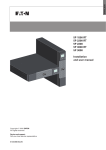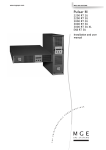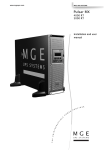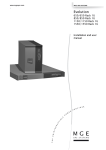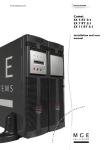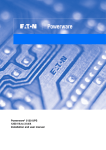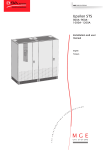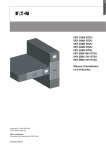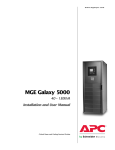Download MGE UPS Systems 2000 RT 2U User manual
Transcript
www.mgeups.com Evolution S 1250 RT 2U S 1750 RT 2U 2000 RT 2U S 2500 RT 2U S 3000 RT 2U S 3000 RT 3U S EXB 1250/1750 RT 2U S EXB 2500/3000 RT 2U S EXB 2500/3000 RT 3U Installation and user manual P O W E R P D E R V I O R T H E U N I N T E R R U P T I B L E 34003641FR/AA - Page 1 34008236EN/AA - Page 2 Introduction Thank you for selecting an MGE UPS SYSTEMS product to protect your electrical equipment. The Evolution range has been designed with the utmost care. We recommend that you take the time to read this manual to take full advantage of the many features of your UPS (Uninterruptible Power System). Before installing Evolution, please read the booklet presenting the safety instructions. Then follow the indications in this manual. To discover the entire range of MGE UPS SYSTEMS products and the options available for the Evolution range, we invite you to visit our web site at www.mgeups.com or contact your MGE UPS SYSTEMS representative. Environmental protection MGE UPS SYSTEMS has implemented an environmental-protection policy. Products are developed according to an eco-design approach. Substances This product does not contain CFCs, HCFCs or asbestos. Packing To improve waste treatment and facilitate recycling, separate the various packing components. ◗ The cardboard we use comprises over 50% of recycled cardboard. ◗ Sacks and bags are made of polyethylene. ◗ Packing materials are recyclable and bear the appropriate identification symbol . Material Abbreviation Number in the symbol Polyethylene terephthalate PET 01 High-density polyethylene HDPE 02 Polyvinyl chloride PVC 03 Low-density polyethylene LDPE 04 Polypropylene PP 05 Polystyrene PS 06 Follow all local regulations for the disposal of packing materials. End of life MGE UPS SYSTEMS will process products at the end of their service life in compliance with local regulations. MGE UPS SYSTEMS works with companies in charge of collecting and eliminating our products at the end of their service life. Product The product is made up of recyclable materials. Dismantling and destruction must take place in compliance with all local regulations concerning waste. At the end of its service life, the product must be transported to a processing centre for electrical and electronic waste. Battery The product contains lead-acid batteries that must be processed according to applicable local regulations concerning batteries. The battery may be removed to comply with regulations and in view of correct disposal. The "Material Safety Data Sheets" (MSDS) for the batteries are available on our web site*. (*) For more information or to contact the Product Environmental manager, use the "Environmental Form" on the site: www.mgeups.com -> About us -> Environment. 34008236EN/AA - Page 3 Introduction Pictograms Important instructions that must always be followed. Information, advice, help. Visual indication. Action. Audio signal. In the illustrations on the following pages, the symbols below are used: LED off LED on LED flashing 34008236EN/AA - Page 4 Contents 1. 2. 3. 4. 5. 6. Presentation 1.1 Standard positions ...................................................................................................................... 6 1.2 Tower position ................................................................................................................................ 6 Rack position ................................................................................................................................. 6 Rear panels................................................................................................................................... 7 1.3 Evolution 2500 / 3000 .................................................................................................................... 7 Evolution 1250 / 1750 / 2000 ......................................................................................................... 7 Evolution EXB (optional battery module) ....................................................................................... 7 Control panel................................................................................................................................ 7 Installation 2.1 Unpacking and contents check .................................................................................................. 8 2.2 Installation in tower position ...................................................................................................... 9 2.3 Installation in rack position ........................................................................................................ 9 2.4 Communication ports................................................................................................................ 10 2.5 Connection of RS232 or USB communication port (optional)...................................................... 10 Installation of the communication cards (optional)....................................................................... 10 Characteristics of the contact communication port (optional) ...................................................... 10 Connections with a FlexPDU (Power Distribution Unit) module ................................................11 2.6 Connections with a HotSwap MBP module..............................................................................11 2.7 HotSwap MBP module operation................................................................................................. 12 UPS connection without a FlexPDU or HotSwap MBP module ............................................. 12 Operation 3.1 Start-up and normal operation ................................................................................................. 13 3.2 Operation on battery power ...................................................................................................... 13 3.3 Return of AC input power ......................................................................................................... 14 3.4 UPS shutdown............................................................................................................................ 14 3.5 UPS remote-control functions .................................................................................................. 14 Personalisation using external software ........................................................................... 16 Maintenance 5.1 Troubleshooting......................................................................................................................... 17 5.2 Troubleshooting a UPS equipped with the HotSwap MBP module ............................................. 17 Battery-module replacement .................................................................................................... 18 5.3 Safety recommendations ............................................................................................................. 18 Battery-module removal............................................................................................................... 18 Mounting the new battery module................................................................................................ 19 Maintenance on a UPS equipped with the HotSwap MBP module........................................ 19 5.4 Training centre ........................................................................................................................... 19 Appendices 6.1 Technical specifications............................................................................................................ 20 6.2 Glossary ..................................................................................................................................... 21 34008236EN/AA - Page 5 1. Presentation 1.1 Standard positions Tower position Dimensions (W x H x D) in mm S 1250 RT 2U S 1750 RT 2U 2000 RT 2U 440 x 86 x 509 S 2500 RT 2U S 3000 RT 2U 440 x 86 x 634 S 3000 RT 3U 440 x 131 x 484 S EXB 1250/1750 RT 2U 440 x 86 x 509 S EXB 2500/3000 RT 2U 440 x 86 x 634 S EXB 2500/3000 RT 3U 440 x 131 x 484 Weights in kg Rack position D H W 34008236EN/AA - Page 6 S 1250 RT 2U 24.3 S 1750 RT 2U 26.6 2000 RT 2U 25.7 S 2500 RT 2U 33.8 S 3000 RT 2U 33.8 S 3000 RT 3U 34.3 S EXB 1250/1750 RT 2U 30.4 S EXB 2500/3000 RT 2U 41.5 S EXB 2500/3000 RT 3U 41.7 1. Presentation 1.2 Rear panels Evolution S 2500 / S 3000 1 4 2 3 6 8 7 5 9 10 Evolution S 1250 / S 1750 / 2000 1 4 2 3 6 8 9 5 (1) USB communication port (2) RS232 communication port (3) Connector for automatic recognition of an additional battery module (4) Slot for optional communication card (5) Connector for ROO (remote ON/OFF) or RPO (Remote Power Off) control (6) Connector for additional battery module (except Evolution 2000) (7) 16 A outlet for connection of equipment (8) Two groups of 2 programmable outlets for connection of equipment (9) Groups of 4 outlets for connection of equipment (10) Socket for connection to AC-power source 10 Evolution S EXB (optional battery module) (12) Connectors for battery modules (to the UPS or to the other battery modules) (13) Connectors for automatic recognition of battery modules 12 12 13 1.3 Control panel 76-100% 51-75% 26-50% 0-25% 20 (20) Bargraph indicating the percent load (21) Bargraph indicating battery charge level (22) Programmable outlets 1 are supplied with power (23) Programmable outlets 2 are supplied with power (24) Lighted ON/OFF button for outlets (25) Load protected LED (26) Downgraded operation LED (27) Load not protected LED 22 1 2 21 23 24 25 26 27 34008236EN/AA - Page 7 2. Installation 2.1 Unpacking and contents check 32 31 30 33 34 35 37 36 38 39 40 42 41 43 ETHERNET Settings/Sensor 100M 10M On = Link Blink = Act UPS data 44 RS232 66102 (30) Evolution UPS Elements supplied depending on the version or optional (31) connection cable to AC-power source (Evolution S 2500 and S 3000 models only) (39) 2 supports for the upright position (RT 2U version only) (32) 2 connection cables for the protected equipment (33) RS232 communication cable (40) FlexPDU module (optional) (41) connection cable between FlexPDU module and UPS (34) USB communication cable (42) NMC communication card (optional, standard on Netpack versions) (35) 2 systems to secure power plugs (43) HotSwap MBP module (optional) (36)Solution-Pac CD-ROM (44) connection cables between HotSwap MBP module and UPS (37) Documentation (38) Mounting kit for 19-inch bays Packing materials must be disposed of in compliance with all local regulations concerning waste. Recycling symbols are printed on the packing materials to facilitate sorting. 34008236EN/AA - Page 8 2. Installation 2.2 Installation in tower position 1 1 2 3 Note. The two supports for the upright position are used on the RT 2U version only. 2.3 Installation in rack position It is advised to first install the battery module, then the power module above. Follow steps 1 to 4 for module mounting on the rails. 1 1 3 1 2 1 4 2 4 The rails and necessary hardware are supplied by MGE UPS SYSTEMS. 34008236EN/AA - Page 9 2. Installation 2.4 Communication ports Connection of RS232 or USB communication port (optional) The RS232 and USB communication ports cannot operate simultaneously. 1 - Connect the RS232 (33) or USB (34) communication cable to the serial or USB port on the computer equipment. 34 2 - Connect the other end of the communication cable (33) or (34) to the USB (1) or RS232 (2) communication port on the UPS. 33 The UPS can now communicate with MGE UPS SYSTEMS power management software. 2 1 Installation of the communication cards (optional, standard on the Netpack versions) 4 Limited-access slot for the communication card It is not necessary to shutdown the UPS before installing a communication card. 1 - Remove the slot cover (4) secured by screws. 2 - Insert the communication card in the slot. 3 - Secure the card cover with the 2 screws. Characteristics of the contact communication port (optional) commun n.o. n.o. 7 8 9 1 2 3 4 5 6 10 ◗ ◗ Pins n.o. 1, 3, 4, 5, 6, 10: not used 2: common (user) ◗ Pin 7: low battery ◗ Pin 8: operation on battery power ◗ Pin 9: UPS ON, equipment supplied ◗ Pin n.o.: normally open contact When a signal is activated, the contact is closed between the common (pin 4) and the pin for the corresponding signal. Contact characteristics (optocoupler) 48 V DC max ◗ Current: 80 mA max ◗ Power: 3.84 W ◗ Voltage: 34008236EN/AA - Page 10 2. Installation 2.5 Connection with a FlexPDU (Power Distribution Unit) module (optional) 1 - Evolution S 2500 / S 3000: connect the UPS input socket (10) to the AC-power source using the cable (31) supplied. Evolution S 1250 / S 1750 / 2000: use the power cable of the protected equipment. 8 Evolution S 2500 / S 3000 7 9 10 31 41 2 - Evolution S 2500 / S 3000: connect the input socket on the FlexPDU module (48) to the UPS outlet (7) using the cable (41) supplied. Evolution S 1250 / S 1750 / 2000: connect the input socket on the FlexPDU module (48) to one of the outlets (9). The cable and the connectors are marked in red. 3 - Connect the equipment to the outlets (45), (46) and (47) on the FlexPDU module. These outlets differ, depending on the version of the FlexPDU module. FlexPDU 45 46 47 48 4 - Fit the connection securing system that prevents the plugs from being pulled out accidentally. 2.6 Connection with a HotSwap MBP module (optional) The HotSwap MBP module makes it possible to service or even replace the UPS without affecting the connected loads (HotSwap function). 1 - Connect the input socket (56) on the HotSwap MBP module to the AC-power source using the cable (31) supplied. 8 Evolution S 2500 / S 3000 2 - Connect the UPS input socket (10) to the "UPS Input" (55) on the HotSwap MBP module, using the cable (44) supplied. These cables and the connectors are marked blue. 7 9 10 44 49 BY PASS SWITCH By-pass Normal UPS ON OK to switch HotSwap MBP 50 51 52 53 54 55 56 31 3 - Evolution S 2500 / S 3000: connect the UPS outlet (7) to the "UPS Output" (54) on the HotSwap MBP module, using the cable (44) supplied. Evolution S 1250 / S 1750 / 2000: connect one of the UPS outlets (9) to the "UPS Output" (54) on the HotSwap MBP module. These cables and the connectors are marked in red. 4 - Connect the equipment to the outlets (49) and (50) on the HotSwap MBP module. These outlets differ, depending on the version of the HotSwap MBP module. Caution. Do not use UPS outlets (8) and (9) to supply equipment because use of switch (53) on the HotSwap MBP module would cut supply to the equipment. 34008236EN/AA - Page 11 2. Installation 51 The HotSwap MBP module has a rotary switch (53) with two positions: Normal - the load is supplied by the UPS, Bypass - the load is supplied directly by the AC-power source. BY PASS SWITCH Normal UPS ON OK to switch By-pass HotSwap MBP module operation 52 53 UPS start-up with the HotSwap MBP module 1 - Check that the UPS is correctly connected to the HotSwap MBP module. 2 - Set switch (53) to Normal position. 3 - Start the UPS by pressing the ON/OFF button (24) on the UPS control panel. The load is supplied by the UPS. LED (51) "UPS ON - OK to switch" on the HotSwap MBP module goes ON. HotSwap MBP module test 1 - Set switch (53) to Bypass position and check that the load is still supplied. 2 - Set switch (53) back to Normal position. 2.7 UPS connection without a FlexPDU or HotSwap MBP module Check that the indications on the name plate located on the back of the UPS correspond to the AC-power source and the true electrical consumption of the total load. 1 - Evolution S 1250 / S 1750 / 2000: connect the UPS input socket (10) to the ACpower source using the cable of the protected equipment. Evolution S 2500 / S 3000: connect the supplied cable (31) (250 V - 16 A) to the socket (10), then to the AC-power source. 2 - Connect the loads to the UPS using the cables (32). It is preferable to connect the priority loads to the four outlets marked (9) and the nonpriority loads to the four outlets marked (8) that can be programmed in pairs (1 and 2). For the Evolution S 2500 / S 3000 models, connect any high-power devices to the 16 A outlet (7). 7 8 9 35 10 32 31 To program shutdown of outlets (8) during operation on battery power and thus optimise the available backup time, the MGE UPS SYSTEMS communication software is required. 3 - Fit the connection securing system (35) that prevents the plugs from being pulled out accidentally. Note. The UPS charges the battery as soon as it is connected to the AC-power source, even if button (24) is not pressed. Once the UPS is connected to the AC-power source, eight hours of charging are required before the battery can supply the rated backup time. 34008236EN/AA - Page 12 3. Operation 3.1 Start-up and normal operation 1 2 21 Press button (24) for approximately 1 second. The buzzer beeps once and all the LEDs go ON simultaneously. ◗ If AC input power is available, button (24) and LED (25) are ON. The load is supplied by the AC-power source. Conditions permitting, the UPS runs a battery test, indicated by LEDs (21) and the buzzer. ◗ If AC input power is not available, button (24) and LEDs (25) and (26) are ON. The load is supplied by the UPS on battery power. ◗ 26 24 25 27 The connected devices are protected by the UPS. If LED (27) is ON, a fault has occurred (see the "Troubleshooting" section). 3.2 Operation on battery power Transfer to battery power ◗ The connected devices continue to be supplied by the UPS when AC input power is no longer available. The necessary energy is provided by the battery. ◗ Button (24) and LEDs (25) and (26) are ON. ◗ The audio alarm beeps every ten seconds. 1 2 26 24 25 The connected devices are supplied by the battery. Low-battery warning ◗ 1 ◗ Button (24) and LEDs (25) and (26) are ON. The audio alarm beeps every three seconds. 2 26 24 25 The remaining battery power is low. Shut down all applications on the connected equipment because automatic UPS shutdown is imminent. 34008236EN/AA - Page 13 3. Operation End of battery backup time ◗ ◗ All the LEDs go OFF. The audio alarms stops. The UPS is completely shut down. 3.3 Return of AC input power Following an outage, the UPS restarts automatically when AC input power returns (unless the restart function has been disabled via UPS personalisation) and the load is again supplied. 3.4 UPS shutdown 1 Press button (24) for approximately 2 seconds. 2 The devices connected to the UPS are no longer supplied. 24 3.5 UPS remote control functions Evolution offers a choice between two remote control functions. ◗ RPO: Remote Power Off allow a remote contact to be used to disconnect all the equipment connected to the UPS. Restarting the UPS requires manual intervention. ◗ ROO: Remote ON/OFF allows remote action of button (24) to shut down the UPS. These functions are obtained by opening a contact connected between the appropriate pins of connector (5) on the rear panel of the UPS (see figures below). 5 Remote control connection and test 1 - Check that the UPS is OFF and disconnected from the AC input source. 2 - Remove connector (5) after unscrewing the screws. 3 - Connect a normally closed volt-free contact (60 V DC / 30 V AC max., 20 mA max., 0.75 mm2 cable cross-section) between the two pins of connector (5) (see diagram). 34008236EN/AA - Page 14 3. Operation 5 ROO Contact open: UPS shutdown Contact closed: UPS start-up (UPS connected to AC power and AC power is available) Note. The local ON/OFF control using button (24) overrides the remote-control function. 5 RPO Contact open: UPS shutdown, LED (26) goes ON To return to normal operation, deactivate the remote external contact (LED (26) goes OFF) and restart the UPS by pressing button (24). 4 - Plug connector (5) into the back of the UPS. 5 - Connect and restart the UPS following the previously described procedures. 6 - Activate the external remote shutdown contact to test the function. Warning. This connector must only be connected to SELV (Safety Extra-Low Voltage) circuits. 34008236EN/AA - Page 15 4. Personalisation using external software Insert the Solution-Pac CD-ROM in the drive. On the first navigation screen, select "Point to Point solution" and follow the instructions on how to install the Personal Solution-Pac software. ◗ Then select "Settings", "Advanced settings" and "UPS settings". Note that the Linux/Unix/MacOS versions of Personal Solution-Pac software do not offer this possibility. It is possible to modify the settings listed below (detailed comments are available in the Personal Solution-Pac software). ◗ ◗ Main-output personalisation Function Factory setting Other available settings Output voltage on battery power 230 Volts AC 200/208/220/240 Volts AC Overload alarm threshold 105% 30/50/70% Function Factory setting Other available settings High threshold for transfer to battery 294 Volts AC 271 to 294 Volts AC Low threshold for transfer to battery 160 Volts AC 160 to 180 Volts AC Fader activation threshold 265 Volts AC 244 to 265 Volts AC Booster activation threshold 184 Volts AC 184 to 207 Volts AC Maximum input-voltage range Disabled Enabled (1) Function Factory setting Other available settings UPS-sensitivity level Normal High or low Function Factory setting Other available settings Automatic start Enabled Disabled Cold start Enabled Disabled Forced shutdown Enabled Disabled Energy-savings mode Disabled Enabled UPS ON/OFF controlled by software Enabled Disabled Battery level before restart 0% 0 to 100% Function Factory setting Other available settings Battery-test intervals Weekly No test / daily test / monthly test Low-battery warning 20% 0 to 100% Battery protection against deep discharge Enabled Disabled Audio alarm Enabled Disabled Additional battery module (Evolution S models only) Automatic detection of number of battery modules For specific batteries, from 25 to 81 Ah Voltage-threshold personalisation (1) Low threshold for transfer to battery is 150 V. UPS-sensitivity personalisation UPS ON/OFF personalisation Battery personalisation 34008236EN/AA - Page 16 5. Maintenance 5.1 Troubleshooting Indication Diagnostic Correction 1 When the UPS is started using button (24), all the LEDs go ON once and the buzzer beeps once, then LED (26) remains ON. The remote power off (RPO) contact has been activated to shut down the UPS and now prevents restart. Set the contact back to its normal position and press button (24) to restart. 2 Button (24) and LEDs (25) and (26) are ON and all the LEDs on bargraph (20) flash. The percent load is greater than the set overload level or UPS capacity. Check the power drawn by the connected devices and disconnect any non-priority devices. Check the overload level setting. 3 Button (24) and LED (27) are ON and all the LEDs on bargraph (20) are flashing. A critical overload has occurred on the UPS output. If AC input power fails, the load will not be supplied in battery mode. Check the power drawn by the connected devices and disconnect any non-priority devices. 4 LED (27) is ON and all the LEDs on bargraph (21) are flashing. A battery fault has been detected during the automatic test. Replace the battery module (see section 5.2, Battery-module replacement). 5 LED (27) alone is ON and the buzzer sounds continuously. A UPS internal fault has occurred and the load is not supplied. Call the after-sales support department. Troubleshooting a UPS equipped with the HotSwap MBP module Indication Diagnostic Correction 6 The load is no longer supplied when the rotary switch (49) on the HotSwap MBP module is set to Bypass position. ◗ The protected devices are connected to the UPS output instead of to the HotSwap MBP module. ◗ The AC-power cord is connected to the UPS input instead of to the HotSwap MBP module. Check the wiring between the UPS and the HotSwap MBP module (see section 2.6). 7 The load is no longer supplied when the rotary switch (49) on the HotSwap MBP module is set to Normal position. ◗ The UPS is shut down. The wiring between the UPS and the HotSwap MBP module is incorrect. Start the UPS. Check the wiring between the UPS and the HotSwap MBP module (see section 2.6). The load is no longer supplied after AC-power fails. ◗ The rotary switch (49) on the HotSwap MBP module is set to Bypass position. ◗ The wiring between the UPS and the HotSwap MBP module is incorrect. Set the rotary switch (49) on the HotSwap MBP module to Normal position. ◗ Check the wiring between the UPS and the HotSwap MBP module (see section 2.6). 8 ◗ ◗ ◗ ◗ If a fault leads to UPS shutdown, press the ON/OFF button (24) to clear the fault. 34008236EN/AA - Page 17 5. Maintenance 5.2 Battery-module replacement Safety recommendations The battery can cause electrocution and high short-circuit currents. The following safety precautions are required before servicing the battery components: ◗ Remove watches, rings, bracelets and all other metal objects from the hands and arms, ◗ Use tools with an insulated handle. Battery-module removal A - Unscrew the left-hand side of the front panel (two screws). B - Remove the part. B A C - Disconnect the battery block by separating the two connectors (never pull on the wires). C D - Remove the metal protection cover in front of the battery (two screws). D E - Pull the plastic tab to remove the battery block and replace it. E 34008236EN/AA - Page 18 5. Maintenance Mounting the new battery module Carry out the above instructions in reverse order. ◗ To ensure safety and high performance, use only batteries supplied by MGE UPS SYSTEMS. care to firmly press together the two parts of the connector during remounting. ◗ Take 5.3 Maintenance on a UPS equipped with the HotSwap MBP module 8 7 9 10 44 49 BY PASS SWITCH By-pass Normal UPS ON OK to switch HotSwap MBP 50 51 52 53 54 55 56 31 The HotSwap MBP module makes it possible to service or even replace the UPS without affecting the connected loads (HotSwap function). Maintenance 1 - Set switch (53) to Bypass position. The red LED on the HotSwap MBP module goes ON, indicating that the load is supplied directly with AC input source power. 2 - Stop the UPS by pressing the ON/OFF button (24) on the UPS control panel. LED (51) "UPS ON - OK to switch" goes OFF, the UPS can now be disconnected and replaced. Return to normal operation 1 - Check that the UPS is correctly connected to the HotSwap MBP module. 2 - Start the UPS by pressing the ON/OFF button (24) on the UPS control panel. LED (51) "UPS ON - OK to switch" on the HotSwap MBP module goes ON (otherwise, there is a connection error between the HotSwap MBP module and the UPS). 3 - Set switch (53) to Normal position. The red LED on the HotSwap MBP module goes OFF. 5.4 Training centre To fully master operation of your MGE UPS SYSTEMS product and carry out level 1 servicing, see our complete range of technical training courses, available in both French and English. 50 Hz training centre 60 Hz training centre MGE UPS SYSTEMS 140 avenue Jean-Kuntzmann Zirst - Montbonnot St-Martin 38334 St-Ismier Cedex FRANCE MGE UPS SYSTEMS 1660 Scenic Avenue Costa Mesa CA 92626 USA Tel. +33 (0)4 76 18 34 14 Fax +33 (0)4 76 18 45 21 [email protected] www.mgepowerlearning.com (Catalogue and registration available on line) Tel. +1 714 557 1637 Fax +1 714 437 9072 [email protected] www.mgepowerlearning.com (Catalogue and registration available on line) 34008236EN/AA - Page 19 6. Appendices 6.1 Technical specifications Filter Transformer (AVR) Charger Inverter Battery Output power Evolution S 1250 Evolution S 1750 Evolution 2000 Evolution S 2500 Evolution S 3000 1250VA/1150W 1750VA/1600W 2000VA/1600W 2500VA/2250W 3000VA/2700W AC input power ◗ Rated input voltage ◗ Input-voltage range ◗ Input-frequency range Single phase 220~240 V 160 V to 294 V (1) 47 to 70 Hz (50 Hz system), 56.5 to 70 Hz (60 Hz system) (2) Output on battery power ◗ Voltage ◗ Frequency Battery (sealed lead acid, maintenance free) ◗ Standard ◗Additional modules possible (up to 4 EXB) 230 V (+6/-10%) (3) 50/60 Hz ±0.1% 4 x 12 V 7.2 Ah 4 x 12 V - 9 Ah Evolution S EXB 1250/1750 (4) Environment ◗ Operating temperature range ◗ Storage temperature range ◗ Relative humidity ◗ Noise level 6 x 12 V 7.2 Ah No 6 x 12 V 9 Ah Evolution EXB S 2500/3000 (5) 0 to 40°C -25°C to 40°C 20 to 90% (without condensation) < 45 dBA < 50 dBA (1) The high and low thresholds can be adjusted using Personal Solution-Pac software. (2) Up to 40 Hz in low-sensitivity mode (programmable using Personal Solution-Pac software. (3) Adjustable to 200 V (10% derating of output power) / 208 V / 220 V / 230 V / 240 V. (4) Battery Evolution S EXB 1250/1750: 2 strings, each 4 x 12 V / 9 Ah. (5) Battery Evolution S EXB 2500/3000: 2 strings, each 6 x 12 V / 9 Ah. When the appliance is used in EU area, use an external circuit breaker in front of line with rating 16A, 250V which is IEC/EN 60898-1 standard compliant; When the appliance is used in America area, use an external circuit breaker in front of line with rating 20A, 250V. This product is designed for IT power distribution system. 34008236EN/AA - Page 20 6. Appendices 6.2 Glossary Backup time Time during which the load can be supplied by the UPS operating on battery power. Battery test Internal UPS test to check battery status. Booster mode Automatic UPS mode that steps up the AC voltage if it is too low, to a level above the personalised set-point, without discharging the battery. Bypass AC input Bypass line from the AC-power source, controlled by the UPS, used to directly supply the load if an overload or a malfunction occurs on the UPS. Cold start The devices connected to the UPS can be started even if AC input power is not available. The UPS operates on battery power alone. Deep discharge Battery discharge beyond the permissible limit, resulting in irreversible damage to the battery. Fader mode Automatic UPS mode that steps down the AC voltage if it is too high, to a level below the personalised set-point, without discharging the battery. FlexPDU Module with UPS outlets for installation in a bay. There are different modules with different types of outlets. HotSwap MBP UPS manual-bypass module for maintenance. There are different modules with different types of outlets. Load Devices or equipment connected to the UPS output. Low-battery warning This is a battery-voltage level indicating that battery power is low and that the user must take action in light of the imminent break in the supply of power to the load. Normal AC input The AC-power line supplying the UPS under normal conditions. Percent load Ratio of the power effectively drawn by the load to the maximum output of the UPS. Personalisation It is possible to modify certain UPS parameters set in the factory. Certain UPS functions can also be modified by the Personal Solution-Pac software to better suit user needs. Programmable outlets Controllable outlets for automatic load shedding, remote shutdown and sequential restart (personalised using Personal Solution-Pac software. UPS Uninterruptible Power System. UPS ON/OFF controlled by software This function enables or disables initiation of UPS ON/OFF control sequences by computer power-management software. 34008236EN/AA - Page 21 e-mail: [email protected] tel: 08-52 400 700 fax: 08-520 18121






















